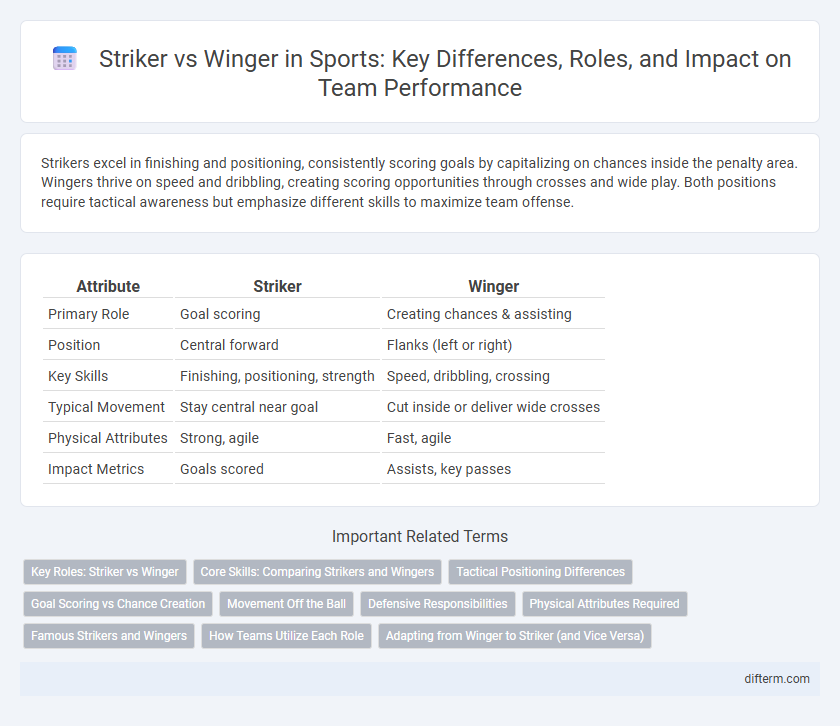Strikers excel in finishing and positioning, consistently scoring goals by capitalizing on chances inside the penalty area. Wingers thrive on speed and dribbling, creating scoring opportunities through crosses and wide play. Both positions require tactical awareness but emphasize different skills to maximize team offense.
Table of Comparison
| Attribute | Striker | Winger |
|---|---|---|
| Primary Role | Goal scoring | Creating chances & assisting |
| Position | Central forward | Flanks (left or right) |
| Key Skills | Finishing, positioning, strength | Speed, dribbling, crossing |
| Typical Movement | Stay central near goal | Cut inside or deliver wide crosses |
| Physical Attributes | Strong, agile | Fast, agile |
| Impact Metrics | Goals scored | Assists, key passes |
Key Roles: Striker vs Winger
Strikers primarily focus on goal-scoring by positioning themselves in the opponent's penalty area, utilizing strong finishing skills and physical presence to convert chances. Wingers excel at creating scoring opportunities through pace, dribbling, and precise crossing from wide areas, often stretching the defense and delivering assists. While strikers are central to offensive finishing, wingers provide crucial width and support that diversify attacking strategies.
Core Skills: Comparing Strikers and Wingers
Strikers excel in clinical finishing, positioning, and aerial ability, consistently converting chances into goals with precise shots and strong off-the-ball movement. Wingers prioritize speed, dribbling, and crossing accuracy, creating scoring opportunities by beating defenders and delivering pinpoint passes into the box. Both roles require tactical awareness and stamina, but strikers focus on goal-scoring instincts while wingers emphasize creating chances and wide play dynamics.
Tactical Positioning Differences
Strikers operate centrally, occupying advanced positions to maximize goal-scoring opportunities by exploiting gaps between defenders. Wingers position themselves near the touchlines, providing width to stretch the opponent's defense and delivering crosses into the penalty area. Tactical positioning demands that strikers focus on penetrating through central channels, while wingers prioritize pace and dribbling skills to beat full-backs and create scoring chances from wide areas.
Goal Scoring vs Chance Creation
Strikers excel in goal scoring with a primary focus on finishing chances inside the box, utilizing positioning and clinical shooting skills. Wingers specialize in chance creation by delivering accurate crosses, dribbling past defenders, and providing assists through key passes. Effective teams balance striking prowess and wing creativity to maximize scoring opportunities and offensive threat.
Movement Off the Ball
Strikers excel in off-the-ball movement by making penetrating runs behind defenders, constantly seeking goal-scoring opportunities in the penalty area. Wingers prioritize width and create space by stretching the defense, using diagonal runs and quick drifts toward the box to deliver crosses or cut inside for shots. Both roles require intelligent positioning and timing to break defensive lines and maximize attacking potential.
Defensive Responsibilities
Strikers primarily focus on goal-scoring but often have limited defensive duties, typically pressing the opposition's central defenders to initiate counter-pressing. Wingers carry significant defensive responsibilities by tracking back to support full-backs, preventing opposition overlaps, and maintaining wide defensive solidity. Effective defensive contribution from wingers helps reduce space for opponent attacks along the flanks, making them crucial in both offensive and defensive transitions.
Physical Attributes Required
Strikers require explosive speed, strength, and agility to outmuscle defenders and execute quick, powerful shots on goal. Wingers rely heavily on pace, acceleration, and exceptional stamina to maintain wide positioning, deliver precise crosses, and perform rapid directional changes. Both positions demand high levels of balance and coordination, but wingers often emphasize endurance while strikers prioritize burst strength.
Famous Strikers and Wingers
Famous strikers like Lionel Messi, Cristiano Ronaldo, and Robert Lewandowski excel in goal-scoring and positioning within the penalty area, driving their teams' offensive threat. Renowned wingers such as Neymar, Arjen Robben, and Raheem Sterling are known for their pace, dribbling skills, and ability to create scoring opportunities from wide positions. Both roles are crucial in modern football tactics, with strikers focusing on finishing and wingers specializing in crossing and stretching defenses.
How Teams Utilize Each Role
Teams utilize strikers primarily as central goal-scoring threats, positioning them to capitalize on scoring opportunities inside the penalty area. Wingers are deployed on the flanks to stretch the opposition's defense, delivering crosses and creating scoring chances through pace and dribbling. Tactical formations often rely on strikers for finishing, while wingers facilitate wide attacks and exploit space on the wings.
Adapting from Winger to Striker (and Vice Versa)
Adapting from winger to striker requires a shift in offensive mindset from creating chances on the flanks to finishing scoring opportunities centrally, emphasizing positioning and sharp shooting skills. Conversely, transitioning from striker to winger demands enhanced dribbling, crossing accuracy, and pace to exploit wide spaces and deliver assists. Mastery of both roles increases tactical flexibility and benefits team dynamics by enabling seamless formation adjustments during matches.
striker vs winger Infographic

 difterm.com
difterm.com